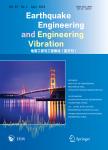Real-time hybrid simulation of structures equipped with viscoelastic-plastic dampers using a user-programmable computational platform
Real-time hybrid simulation of structures equipped with viscoelastic-plastic dampers using a user-programmable computational platform作者机构:Kinetica1235 Bay St.Suite 1004ONM5R 3K4 Department of Civil EngineeringUniversity of Waterloo200 University Avenue WWaterlooONN2L 3G1Canada Department of Civil EngineeringUniversity of Toronto35 St.George StreetTorontoONM5S 1A4Canada
出 版 物:《Earthquake Engineering and Engineering Vibration》 (地震工程与工程振动(英文刊))
年 卷 期:2017年第16卷第4期
页 面:693-711页
核心收录:
学科分类:081405[工学-防灾减灾工程及防护工程] 08[工学] 080203[工学-机械设计及理论] 0802[工学-机械工程] 0814[工学-土木工程]
基 金:NSERC Discovery under Grant 371627-2009 and NSERC RTI under Grant 374707-2009 EQPEQ programs
主 题:real-time hybrid simulation user-programmable computational/control platform supplemental dampers performance spectra
摘 要:A user-programmable computational/control platform was developed at the University of Toronto that offers real-time hybrid simulation (RTHS) capabilities. The platform was verified previously using several linear physical substructures. The study presented in this paper is focused on further validating the RTHS platform using a nonlinear viscoelastic-plastic damper that has displacement, frequency and temperature-dependent properties. The validation study includes damper component characterization tests, as well as RTHS of a series of single-degree-of-freedom (SDOF) systems equipped with viscoelastic-plastic dampers that represent different structural designs. From the component characterization tests, it was found that for a wide range of excitation frequencies and friction slip loads, the tracking errors are comparable to the errors in RTHS of linear spring systems. The hybrid SDOF results are compared to an independently validated thermal- mechanical viscoelastic model to further validate the ability for the platform to test nonlinear systems. After the validation, as an application study, nonlinear SDOF hybrid tests were used to develop performance spectra to predict the response of structures equipped with damping systems that are more challenging to model analytically. The use of the experimental performance spectra is illustrated by comparing the predicted response to the hybrid test response of 2DOF systems equipped with viscoelastic-plastic dampers.



